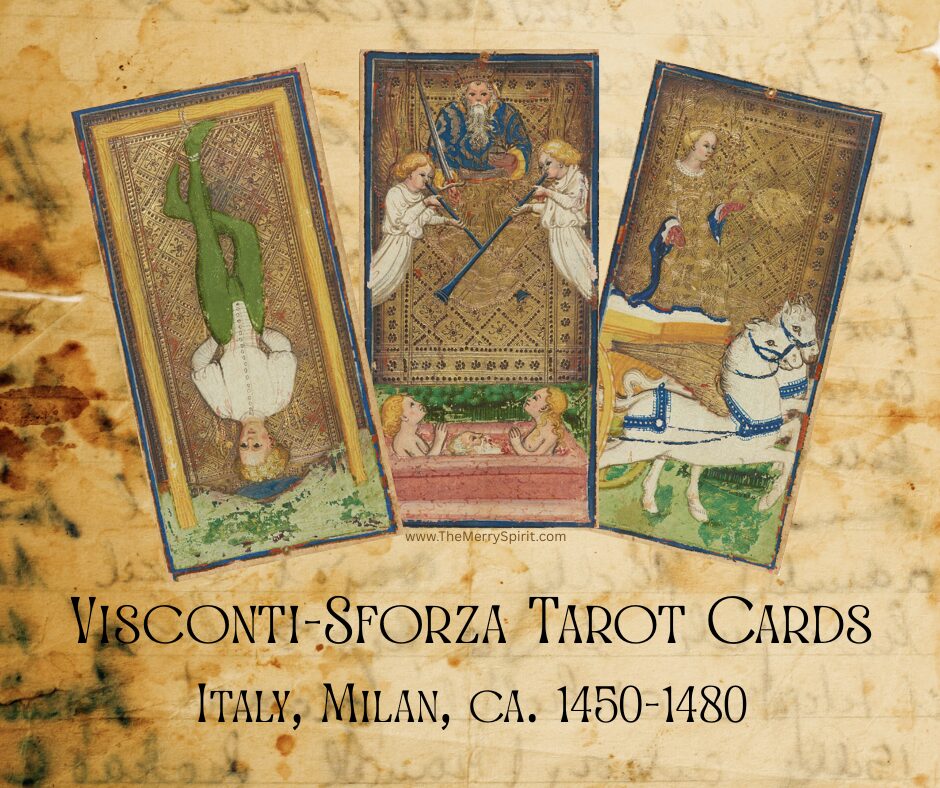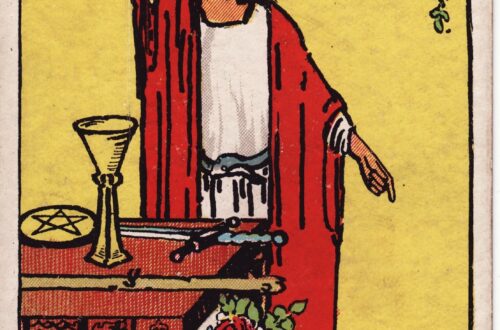Exploring the World of The Tarot: A Blog Series – History

The First Tarot Decks
In the 15th century, Italian nobles played a game called Tarocchi. It was similar to bridge. The first known Tarot decks appeared in Milan, Ferrara, and Bologna. These decks were beautifully hand-painted and expensive, often custom-made for wealthy families.
The most famous was the Visconti-Sforza Tarot, created for the ruling family of Milan. These early decks had four suits, much like modern playing cards, along with a set of trump cards. These trump cards, later known as the Major Arcana, featured allegorical images representing virtues, celestial bodies, and social roles.
Unlike today’s Tarot, these decks had no fixed meanings. They were not used for fortune-telling but for a trick-taking game played by nobility. The game spread across Italy, and as printing technology improved, Tarot cards became more widely available. However, they remained a game for centuries before taking on a mystical role.
The Symbolism of Early Tarot Decks and Its Influence on Mysticism
The earliest Tarot decks, like the Visconti-Sforza, weren’t designed for divination, but their imagery carried deep symbolic meaning. The trump cards (what we now call the Major Arcana) depicted figures like The Emperor, The Empress, The Wheel of Fortune, and Death—ideas drawn from medieval European culture, religious beliefs, and classical philosophy.
Medieval and Religious Influences
Many of these images reflected Christian and moral themes. For example:
- The Pope (later The Hierophant) represented religious authority.
- The Devil illustrated the dangers of temptation.
- The Wheel of Fortune symbolized the unpredictability of fate, a common medieval belief.
These themes resonated with Renaissance society, which was deeply influenced by Christianity, astrology, and classical philosophy. While these cards were just part of a game, their symbolic weight made them fertile ground for later mystical interpretations.
From Italy to France
Over time, Tarot spread beyond Italy. In the 16th and 17th centuries, the French developed their own version, the Tarot de Marseille. This deck set the standard for Tarot imagery, influencing later designs. Unlike the elaborate hand-painted Italian decks, the Tarot de Marseille was mass-produced using woodblock printing, making it more affordable and widely available.
The Structure of the Tarot de Marseille
This deck followed the same basic format as the Italian Tarot, consisting of:
- 22 Major Arcana cards, featuring archetypal figures like The Fool, The Magician, and The World.
- 56 Minor Arcana cards, divided into four suits: Swords, Cups, Coins (later Pentacles), and Batons (later Wands).
However, one major difference set the Tarot de Marseille apart its simpler, more uniform design. Unlike earlier decks, where illustrations varied, the Marseille style became more standardized, with bold lines and primary colors that made it easy to reproduce.
Tarot’s Shift Toward Divination
For most of its early history, Tarot was still primarily a game. But by the 18th century, thinkers like Antoine Court de Gébelin and Jean-Baptiste Alliette (Etteilla) began reinterpreting the Tarot de Marseille as a mystical tool.
- Court de Gébelin argued that Tarot contained lost wisdom from ancient Egypt, even though there was no historical evidence for this claim.
- Etteilla, a French occultist, created the first Tarot deck specifically for divination, assigning meanings to the cards and introducing reversed interpretations.
These ideas laid the groundwork for Tarot’s transformation into a spiritual and psychological tool, rather than just a game.
A Lasting Influence
The Tarot de Marseille remains one of the most recognizable and respected decks in the world. Even modern decks, like the Rider-Waite Tarot, borrowed heavily from its structure and imagery. Today, many Tarot readers still use the Marseille deck, valuing its raw, symbolic power and historical significance.
Tarot and the Occult Revival of the 19th Century
By the 19th century, Tarot had fully transitioned from a card game into a spiritual and mystical tool. This shift was largely driven by the rise of occultism, a movement that sought hidden truths in ancient traditions, alchemy, astrology, and Kabbalah. Secret societies and esoteric thinkers began to view Tarot as more than just a fortune-telling device it became a key to understanding the universe and the human psyche.
The Influence of Eliphas Lévi
One of the most influential figures in this transformation was Eliphas Lévi, a French occultist. In his 1854 book Dogme et Rituel de la Haute Magie (Dogma and Ritual of High Magic), Lévi claimed that Tarot was linked to the Hebrew Kabbalah, particularly the 22 paths of the Tree of Life. This idea connected the 22 Major Arcana cards with deep spiritual meaning, tying them to cosmic forces, numerology, and astrology.
Lévi also reshaped the interpretation of The Fool card, associating it with the mystical concept of the soul’s journey. His work deeply influenced later occult groups, including the Hermetic Order of the Golden Dawn.
The Golden Dawn and the Modernization of Tarot
Founded in the late 19th century, the Hermetic Order of the Golden Dawn was a secret society that combined Western esoteric traditions, including alchemy, astrology, and Kabbalah. Golden Dawn members saw Tarot as a tool for self-discovery and enlightenment, rather than just fortune-telling.
They assigned new meanings and astrological correspondences to the cards, further systematizing Tarot as a spiritual framework. Key figures in the Golden Dawn such as Arthur Edward Waite and Aleister Crowley—would go on to create two of the most famous tarot decks of all time:
The Rider-Waite-Smith Revolution (1909)
One of the most important shifts in Tarot history came with the Rider-Waite Tarot deck, created by Arthur Edward Waite and illustrated by Pamela Colman Smith. This deck made Tarot:
- Easier to read – Unlike previous decks, where the Minor Arcana were simple numbered pips (like a deck of playing cards), Smith’s artwork gave each card a narrative scene.
- Highly symbolic – The imagery was infused with Christian mysticism, alchemy, astrology, and Kabbalah, making it a powerful spiritual tool.
- Mass-produced – Thanks to new printing methods, the deck became widely available, solidifying Tarot’s place in popular culture.
To this day, the Rider-Waite-Smith deck (as it’s now called) remains the most widely used Tarot deck in the world.
Aleister Crowley and the Thoth Tarot (1944)
While Rider-Waite-Smith became mainstream, Aleister Crowley, a former Golden Dawn member, introduced a darker, more esoteric deck. His Thoth Tarot, illustrated by Lady Frieda Harris, featured:
- Complex symbolism drawn from Egyptian mythology, astrology, and numerology.
- Vibrant, surreal imagery that emphasized personal transformation.
- A bold reworking of traditional Tarot concepts, renaming some cards and redefining their meanings.
Though not as widely used as the Rider-Waite-Smith deck, the Thoth Tarot remains one of the most studied and respected decks among serious Tarot practitioners.
Tarot and the New Age Movement (1960s–1990s)
The 1960s and 1970s saw a massive spiritual revival, with people seeking wisdom outside of traditional religion. Tarot became linked to New Age beliefs, alongside astrology, meditation, and energy healing. During this time:
- More Tarot decks were created, reflecting different cultural and artistic styles.
- Tarot became associated with self-exploration rather than just fortune-telling.
- Books and courses on Tarot flourished, making learning more accessible.
By the 1990s, Tarot had fully entered mainstream culture. It appeared in movies, TV shows, and literature, often depicted as a mystical tool for personal insight.
Tarot in the Digital Age (2000s–Today)
With the rise of the internet, Tarot experienced another transformation. Now, anyone can learn Tarot online, and digital readings are more common than ever. Some major trends include:
- Tarot apps and online readings making it easy to access Tarot anytime.
- A boom in diverse and inclusive decks, representing different cultures, genders, and spiritual beliefs.
- Psychological Tarot, with many using the cards as a tool for personal growth rather than supernatural prediction.
Today, Tarot is more popular than ever, embraced by beginners, spiritual seekers, and even therapists. Whether used for guidance, meditation, or self-reflection, it continues to evolve while staying rooted in its centuries-old history.
Exploring the World of The Tarot: A Blog Series
Table of Contents
- The table of contents will be updated as new blog posts are published. If something is not linked it hasn’t been written yet.
The perfect tarot deck for the beginn





